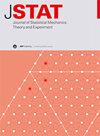Cell information processing via frequency encoding and excitability
IF 1.9
3区 物理与天体物理
Q2 MECHANICS
Journal of Statistical Mechanics: Theory and Experiment
Pub Date : 2024-06-16
DOI:10.1088/1742-5468/ad4af8
引用次数: 0
Abstract
Cells continuously interact with their environment mediating their responses through signaling cascades. Very often, external stimuli induce pulsatile behaviors in intermediaries of the cascade of increasing frequency with the stimulus strength. This is characteristic of intracellular Ca2+ signals involving Ca2+ release through Inositol Trisphosphate Receptors (IP3Rs). The mean frequency of IP3R-mediated Ca2+ pulses has been observed to scale exponentially with the stimulus strength in many cell types. In this paper we use a simple ODE model of the intracellular Ca2+ dynamics for parameters for which there is one excitable fixed point. Including fluctuations through an additive noise term, we derive the mean escape rate from the stationary state and, thus, the mean interpulse time, as a function of the fraction, β, of readily openable IP3Rs. Using an IP3R kinetic model, experimental observations of spatially resolved Ca2+ signals and previous estimates of the IP3 produced upon stimulation we quantify the fluctuations and relate β to [IP3] and the stimulus strength. In this way we determine that the mean interpulse time can be approximated by an exponential function of the latter for ranges such that the covered mean time intervals are similar or larger than those observed experimentally. The study thus provides an easily interpretable explanation, applicable to other pulsatile signaling intermediaries, of the observed exponential dependence between frequency and stimulus, a key feature that makes frequency encoding qualitatively different from other ways commonly used by cells to ‘read’ their environment.通过频率编码和兴奋性进行细胞信息处理
细胞通过信号级联不断与周围环境发生相互作用,从而做出反应。通常,外部刺激会在级联的中间体中引起脉冲行为,频率随刺激强度的增加而增加。这是细胞内 Ca2+ 信号的特点,其中涉及通过三磷酸肌醇受体(IP3R)释放 Ca2+。据观察,在许多细胞类型中,IP3R 介导的 Ca2+ 脉冲的平均频率与刺激强度成指数关系。在本文中,我们使用了一个简单的细胞内 Ca2+ 动态 ODE 模型,该模型的参数为一个可激发的固定点。通过加性噪声项的波动,我们得出了从静止状态逃逸的平均速率,并由此得出了平均脉冲间时间,它是易开放 IP3R 的分数 β 的函数。利用 IP3R 动力学模型、对空间分辨 Ca2+ 信号的实验观察以及之前对刺激时产生的 IP3 的估计,我们对波动进行了量化,并将β与[IP3]和刺激强度联系起来。通过这种方法,我们确定平均脉冲间时间可以用后者的指数函数近似表示,其范围是所覆盖的平均时间间隔与实验观察到的时间间隔相似或更大。因此,这项研究为观察到的频率与刺激之间的指数依赖关系提供了一种易于解释的解释,适用于其他脉冲信号中间体。
本文章由计算机程序翻译,如有差异,请以英文原文为准。
求助全文
约1分钟内获得全文
求助全文
来源期刊
CiteScore
4.50
自引率
12.50%
发文量
210
审稿时长
1.0 months
期刊介绍:
JSTAT is targeted to a broad community interested in different aspects of statistical physics, which are roughly defined by the fields represented in the conferences called ''Statistical Physics''. Submissions from experimentalists working on all the topics which have some ''connection to statistical physics are also strongly encouraged.
The journal covers different topics which correspond to the following keyword sections.
1. Quantum statistical physics, condensed matter, integrable systems
Scientific Directors: Eduardo Fradkin and Giuseppe Mussardo
2. Classical statistical mechanics, equilibrium and non-equilibrium
Scientific Directors: David Mukamel, Matteo Marsili and Giuseppe Mussardo
3. Disordered systems, classical and quantum
Scientific Directors: Eduardo Fradkin and Riccardo Zecchina
4. Interdisciplinary statistical mechanics
Scientific Directors: Matteo Marsili and Riccardo Zecchina
5. Biological modelling and information
Scientific Directors: Matteo Marsili, William Bialek and Riccardo Zecchina

 求助内容:
求助内容: 应助结果提醒方式:
应助结果提醒方式:


